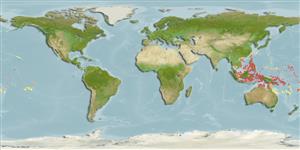Environment: milieu / climate zone / depth range / distribution range
Ecología
marino asociado a arrecife; rango de profundidad 0 - 12 m (Ref. 9710). Tropical
Western Central Pacific: Indonesia, New Guinea, Solomon Islands and Palau in Micronesia.
Tamaño / Peso / Age
Maturity: Lm ? range ? - ? cm
Max length : 11.0 cm TL macho / no sexado; (Ref. 48636)
Espinas dorsales (total): 12; Radios blandos dorsales (total): 17-19; Espinas anales 2; Radios blandos anales: 17 - 20. Identified by the red spots over the back and sides towards the tail, and the large breast spot (Ref. 48636).
Facultative air-breathing (Ref. 126274); Adults are found solitary on coral outcrops (Ref. 90102). They inhabit shallow lagoon reefs, on algal covered rocks and rubble (Ref. 9710). Feed on algae growing at the coral bases. Oviparous. Eggs are demersal and adhesive (Ref. 205), and are attached to the substrate via a filamentous, adhesive pad or pedestal (Ref. 94114). Larvae are planktonic, often found in shallow, coastal waters (Ref. 94114). Maximum depth reported by Ref. 48636.
Life cycle and mating behavior
Madurez | Reproducción | Puesta | Huevos | Fecundidad | Larva
Oviparous, distinct pairing (Ref. 205).
Myers, R.F., 1991. Micronesian reef fishes. Second Ed. Coral Graphics, Barrigada, Guam. 298 p. (Ref. 1602)
IUCN Red List Status (Ref. 130435)
Threat to humans
Harmless
Human uses
Más información
ReferenciasAcuiculturaPerfil de acuiculturaRazasGenéticaElectrophoresesheritabilidadEnfermedadesProcesamientoNutrientsMass conversion
ColaboradoresImágenesStamps, Coins Misc.SonidosCiguateraVelocidadTipo de nataciónSuperficie branquialOtolitosCerebrosVisión
Herramientas
Special reports
Download XML
Fuentes de Internet
Estimates based on models
Preferred temperature (Ref.
123201): 27.4 - 29.3, mean 28.8 °C (based on 1360 cells).
Phylogenetic diversity index (Ref.
82804): PD
50 = 0.5001 [Uniqueness, from 0.5 = low to 2.0 = high].
Bayesian length-weight: a=0.01072 (0.00480 - 0.02393), b=3.01 (2.82 - 3.20), in cm total length, based on LWR estimates for this (Sub)family-body shape (Ref.
93245).
Nivel trófico (Ref.
69278): 2.0 ±0.00 se; based on food items.
Resiliencia (Ref.
120179): Alto, población duplicada en un tiempo mínimo inferior a 15 meses (Preliminary K or Fecundity.).
Fishing Vulnerability (Ref.
59153): Low vulnerability (10 of 100).
Nutrients (Ref.
124155): Calcium = 131 [70, 225] mg/100g; Iron = 0.891 [0.529, 1.461] mg/100g; Protein = 18.4 [17.2, 19.5] %; Omega3 = 0.125 [0.075, 0.206] g/100g; Selenium = 20.7 [11.5, 39.8] μg/100g; VitaminA = 113 [33, 391] μg/100g; Zinc = 2.5 [1.7, 3.6] mg/100g (wet weight);
